
A driver remotely steers a modified utility vehicle through an obstacle course of barrels and cones dotting a Michigan field. A researcher tells the driver to keep the wheel straight—putting the vehicle on a collision course with a barrel. But the vehicle steers itself around the obstacle, handing control back to the driver once the danger has passed.
A new semiautonomous safety system developed by PhD student Sterling Anderson and Karl Iagnemma of MIT’s Robotic Mobility Group uses an onboard camera and laser range finder to identify nearby hazards. An algorithm analyzes the data and identifies safe zones where there’s no danger of colliding with, say, barrels in a field or other cars on the road. When a driver is in danger of leaving a safe zone, the system takes the wheel.
Anderson and Iagnemma identified safe zones by dividing a vehicle’s environment into triangles, with certain edges representing an obstacle or lane boundary. Their algorithm “constrains” obstacle-abutting edges, allowing a driver to navigate across any unconstrained triangle edge. If a driver is in danger of crossing a constrained edge—for instance, if he’s fallen asleep and is about to run into a barrier—the system, which Anderson calls an “intelligent copilot,” steers the car back into the safe zone.
The researchers hope to pare down the system so it can operate on a single cell phone.
Keep Reading
Most Popular
Large language models can do jaw-dropping things. But nobody knows exactly why.
And that's a problem. Figuring it out is one of the biggest scientific puzzles of our time and a crucial step towards controlling more powerful future models.
The problem with plug-in hybrids? Their drivers.
Plug-in hybrids are often sold as a transition to EVs, but new data from Europe shows we’re still underestimating the emissions they produce.
How scientists traced a mysterious covid case back to six toilets
When wastewater surveillance turns into a hunt for a single infected individual, the ethics get tricky.
Google DeepMind’s new generative model makes Super Mario–like games from scratch
Genie learns how to control games by watching hours and hours of video. It could help train next-gen robots too.
Stay connected
Get the latest updates from
MIT Technology Review
Discover special offers, top stories, upcoming events, and more.